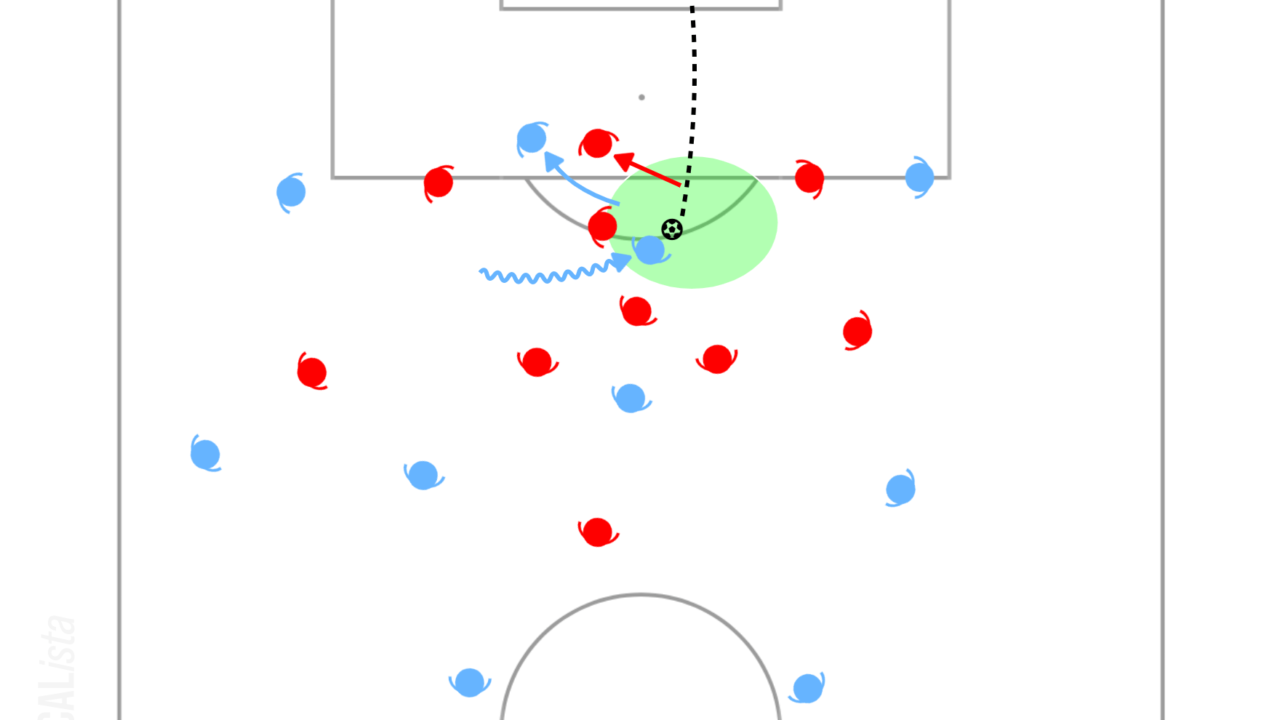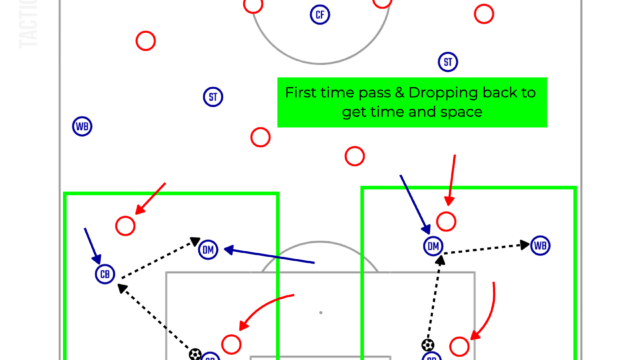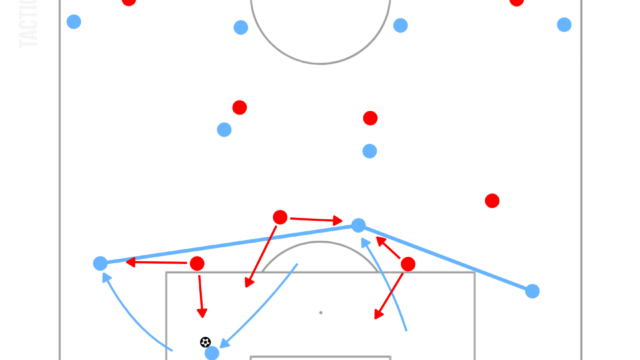Introduction
The clearest objective in football is scoring goals. Perfect defence can only provide a draw, so it is required to score a goal to win a game. In order to score a goal, or increase the probability of scoring a goal, it is important to progress the ball into the space in front of the goal and find a spare attacker there. However, a goal can be scored by a long shot from the outside of the box or a header by gambling. It is always controversial when a midfielder chose a pass to one of the teammates in the box and the ball was intercepted instead of taking a shot from the distance. Of course, there is a risk of playing the ball too much, but at least they have an idea about how to play through the tight defensive block and are just being patient. On the other hand, if teams keep relying on gambling or an individual quality, they will not be able to be effective in breaking the opposition deep defensive block down when the situation occurs. In this article, it is going to be analysed how to create chances against an opposition defensive deep block.
Through the Middle
The best way to create chances is playing through the back line in the middle. When trying to progress the ball into the box from wide areas, in addition to the ball side fullback and centre back, there are the opposite side fullback and centre back in the box. After beating the ball side fullback and delivering a cross, therefore, still the centre backs and the opposite side fullback are waiting for it in front of the goal. However, if the ball is played through in the middle, there are only centre backs to beat to take a shot. Obviously, to stop this, the opposition fullbacks would squeeze into the middle, but it important to have a threat to exploit the gaps in the middle as soon as the space between the opposition defenders is created.
The basic idea is creating a spare player and there are mainly two ways. Firstly, it is possible to receive the ball away from the pressure to take a shot by running through the gap between the opposition defenders.

The situation illustrated above is one of the most effective ways to play through the back line in the middle. The position of the attacker receiving the through pass is difficult to mark by defenders because the fullback is often distracted by the winger and it can be the blind side for the centre back. Additionally, the pass from the inside to outside makes it easier for the attacker to take a shot by receiving the ball facing the goal. In order to do it, the defensive midfielder in the middle needs to be able to face forward when receiving the ball. It is often seen that the defensive midfielder receives the ball and plays it to the other side against the opposition low defensive block without looking for an option to play through. However, just switching the ball from one side to the other makes it easier and predictable for the opposition players. Thus, it is important for them to create a gap between the opposition defenders by disturbing the tempo of shuffling across and find the option to play though.
In the case when the fullback tucks in to mark the attacker between the fullback and centre back, it will be the winger to run in behind to break the opposition back line.

The arced and blind side run from the winger is always effective, but the difficulty of passes in behind is higher. Usually, due to the congested area in the middle, the pass to the winger running in behind will be lofted because it needs to be played over the opposition fullback or wingback. Therefore, teams who do not want to lose the ball frequently might avoid this pattern and the defensive midfielder simply plays to the winger’s feet to drag the opposition fullback out to progress the ball to the inside of the box.
Secondly, after successfully breaking the opposition midfield line, it is possible to create a 2v1 against the opposition centre back.

By carrying the ball forward after receiving the ball in between the lines, one of the defenders will be forced to step up to apply pressure on the ball. Otherwise, the attacker on the ball would progress into the box and take a shot comfortably. Therefore, one of the defenders needs to stop dropping back or step up to close the attacker on the ball down around the edge of the box. However, it will create a gap behind the defender who stepped up. It might be tiny, but if the size of the gap is bigger than the size of the ball, it can be played through and it can be crucial in the box.
Additionally, the movement to exploit the gap between the defenders is often diagonal. Thus, even if the attacker cannot receive the through pass, the movement itself can create another gap for the player on the ball.

In this case, if the opposition left fullback tries to close the player on the ball down, the right winger can exploit the gap in behind. Overall, therefore, the process of breaking the back line in the middle is trying to exploit the gap if it is huge enough to play through, creating a gap by carrying the ball forward in between the lines and disturbing the defenders by creating and exploiting gaps repeatedly.
From Wide Areas
So far, it was discussed how to break the opposition back line in the middle. However, those situations are based on the assumption which is that the opposition midfield line or forward line is not organised enough to apply pressure on the defensive midfielders or screen the passing lanes to the attackers in between the lines, or simply the build up of the attacking team is excellent.
Therefore, if the opposition striker keeps marking the defensive midfielder tightly to prevent from receiving the ball or the opposition midfield line closes the distance between each other extremely well, it is difficult to play through in the middle. In this case, the ball should be played to wide areas to find another way to progress the ball into the box and also force the opposition players to shuffle across, which can stretch the opposition lines.
The orthodox but quite effective pattern in wide areas is the combination of the winger on the ball and the fullback overlapping. This makes it possible to create a 2v1 against the opposition fullback. Then, the winger can play through to let the fullback deliver a cross from the outside of the box or dribble inside. Or, even when the opposition winger manages to come back to nullify the overload, the movement of overlapping forces the opposition fullback and winger to swap each marker, which can create a slight gap between them. Thus, the winger can exploit the gap by dribbling inside because both opposition fullback and winger are often moving towards the goal line, and it is difficult to manage to change the direction quickly.

The detail of the movements of fullbacks in the final third was discussed in this article below.
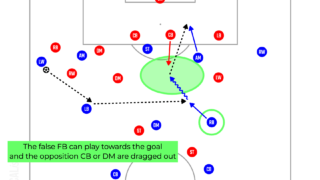
However, there are some weaknesses of this pattern. Firstly, it is not effective to deliver a cross from deep and wide areas. During attacking wide areas, the opposition defenders or defensive midfielders in the middle can wait and be ready for defending crosses, so it is solid in the box. Additionally, this requires the quality of wingers to dribble inside. As it was mentioned, the opposition players in the middle are not influenced by the fullback’s movement of overlapping. Therefore, the winger needs to solve the situation even after beating the opposition fullback or winger because the opposition players covering them are waiting.
This is one of the reasons why underlapping or running in channels is better than just overlapping. Of course, overlapping can be crucial especially when the winger possesses the ball at the edge of the box because the fullback can deliver a cross closer to the goal after overlapping. However, underlapping or running into channels is better.
Firstly, it is possible to deliver crosses closer to the goal compared to crosses after overlapping. Crosses within the box can be low crosses, or last passes which are more accurate and easier for the attackers in the box to be found.
Secondly and more importantly, it is possible to disturb the opposition players in the box. If someone runs into channels, it will be a job for the centre back or defensive midfielder to deal with the movement. Thus, one of them needs to leave the middle, which can create a gap for the team in possession to exploit.

After exploiting the gap made by the movement of running into the channel, it is possible to create a 2v1 against one of the opposition centre backs like it was mentioned in the previous chapter.
So far, how effective it is to run into channels was discussed. However, there is also a weakness. Unlike the overlaps, the movement is from the inside to the outside, so after receiving the ball, the player on the ball often faces the outside, which makes it difficult to play towards the goal. To overcome this problem, who to run will be important.
Firstly, if the winger runs towards the box diagonally from a one-two or through pass, it is possible to play towards the goal, which makes it easier to deliver a cross.

However, similar to overlaps, after missing the timing to play a one-two after the winger has already run in behind, it is difficult to use the movement as a decoy to create a gap in the opposition defensive block. The movement from the inside to the outside can force the opposition centre backs or defensive midfielders to move wide to follow, but the movement from the outside to the inside cannot do it. There are always strengths and weaknesses, so if being able to pick the tactics depending on the situation, it will be great.
From the defensive perspective, in order to prevent these tactics, it is a good idea to have five players at the back or midfield. If there are five defenders at the back, the gap between the channel is tighter and if there are five midfielders, it is possible to cover the space vacated by the 8 (one of the attacking midfielders) who followed the opposition run into the channel.
Tactical solution will be trying to break the line of four or three players. Unless the opposition team defends with a 5-5, it will be a 5-4-1, 5-3-2 or 4-5-1 to have five players in a line. Therefore, either a back line or midfield line is formed by less than five players, which is more exploitable than the line of five players.
For example, if it is a back five, it is difficult to play into channels as an extra defender is covering the space. Thus, trying to break the midfield line and use the space in between the lines will be key. On the other hand, if it is a midfield five, the space in channels can be exploited as usual. Obviously, an extra defender can cover the midfield line or an extra midfielder can cover the back line. So, it is important to find a right moment by switching the ball. But one thing to remember is that, as it was noted in the previous chapter, the priority is to find a gap in the middle to exploit and not to stick to just switching the ball.
The article below explains the factors to make switching play better.
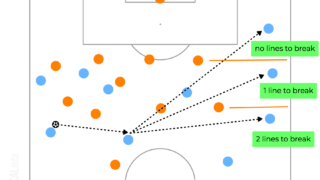
Conclusion
It is extremely difficult to break the opposition deep defensive block down. However, by trying to play through and progress the ball into the box, it will be possible to be effective rather than just gambling. In this article, it had been analysed how to break the lines in the final third. I hope you enjoyed this. Thanks for reading.
